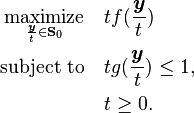Fractional programming
In mathematical optimization, fractional programming is a generalization of linear-fractional programming. The objective function in a fractional program is a ratio of two functions that are in general nonlinear. The ratio to be optimized often describes some kind of efficiency of a system.
Definition
Let  be real-valued functions defined on a set
be real-valued functions defined on a set  . Let
. Let  . The nonlinear program
. The nonlinear program
where  on
on  , is called a fractional program.
, is called a fractional program.
Concave fractional programs
A fractional program in which f is nonnegative and concave, g is positive and convex, and S is a convex set is called a concave fractional program. If g is affine, f does not have to be restricted in sign. The linear fractional program is a special case of a concave fractional program where all functions  are affine.
are affine.
Properties
The function  is semistrictly quasiconcave on S. If f and g are differentiable, then q is pseudoconcave. In a linear fractional program, the objective function is pseudolinear.
is semistrictly quasiconcave on S. If f and g are differentiable, then q is pseudoconcave. In a linear fractional program, the objective function is pseudolinear.
Transformation to a concave program
By the transformation  , any concave fractional program can be transformed to the equivalent parameter-free concave program [1]
, any concave fractional program can be transformed to the equivalent parameter-free concave program [1]
If g is affine, the first constraint is changed to  and the assumption that f is nonnegative may be dropped.
and the assumption that f is nonnegative may be dropped.
Duality
The Lagrangean dual of the equivalent concave program is
Notes
- ↑ Schaible, Siegfried (1974). "Parameter-free Convex Equivalent and Dual Programs". Zeitschrift für Operations Research 18 (5): 187–196. doi:10.1007/BF02026600. MR 351464.
References
- Avriel, Mordecai; Diewert, Walter E.; Schaible, Siegfried; Zang, Israel (1988). Generalized Concavity. Plenum Press.
- Schaible, Siegfried (1983). "Fractional programming". Zeitschrift für Operations Research 27: 39–54.


